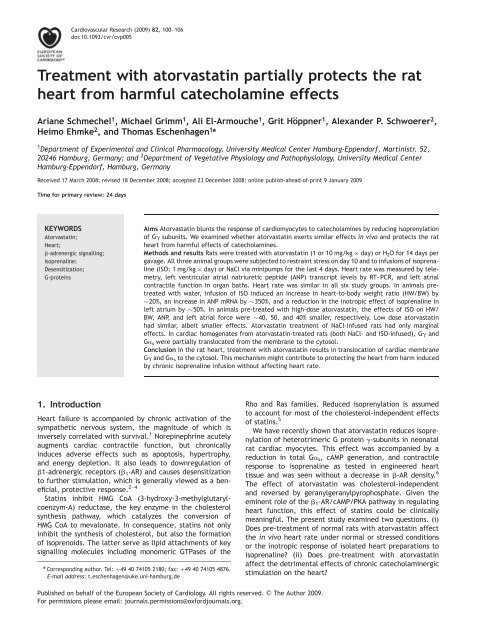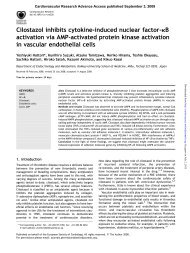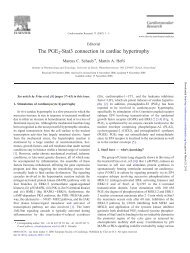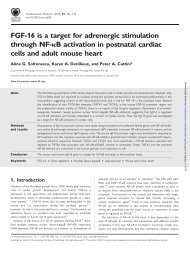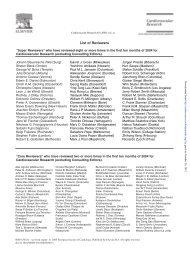Treatment with atorvastatin partially protects the rat heart from ...
Treatment with atorvastatin partially protects the rat heart from ...
Treatment with atorvastatin partially protects the rat heart from ...
- No tags were found...
You also want an ePaper? Increase the reach of your titles
YUMPU automatically turns print PDFs into web optimized ePapers that Google loves.
<strong>Treatment</strong> <strong>with</strong> <strong>atorvastatin</strong> <strong>partially</strong> <strong>protects</strong> <strong>the</strong> <strong>rat</strong><br />
<strong>heart</strong> <strong>from</strong> harmful catecholamine effects<br />
Ariane Schmechel 1 , Michael Grimm 1 , Ali El-Armouche 1 , Grit Höppner 1 , Alexander P. Schwoerer 2 ,<br />
Heimo Ehmke 2 , and Thomas Eschenhagen 1 *<br />
1 Department of Experimental and Clinical Pharmacology, University Medical Center Hamburg-Eppendorf, Martinistr. 52,<br />
20246 Hamburg, Germany; and 2 Department of Vegetative Physiology and Pathophysiology, University Medical Center<br />
Hamburg-Eppendorf, Hamburg, Germany<br />
Received 17 March 2008; revised 18 December 2008; accepted 23 December 2008; online publish-ahead-of-print 9 January 2009<br />
Time for primary review: 24 days<br />
KEYWORDS<br />
Atorvastatin;<br />
Heart;<br />
b-adrenergic signalling;<br />
Isoprenaline;<br />
Desensitization;<br />
G-proteins<br />
1. Introduction<br />
Cardiovascular Research (2009) 82, 100–106<br />
doi:10.1093/cvr/cvp005<br />
Heart failure is accompanied by chronic activation of <strong>the</strong><br />
sympa<strong>the</strong>tic nervous system, <strong>the</strong> magnitude of which is<br />
inversely correlated <strong>with</strong> survival. 1 Norepinephrine acutely<br />
augments cardiac contractile function, but chronically<br />
induces adverse effects such as apoptosis, hypertrophy,<br />
and energy depletion. It also leads to downregulation of<br />
b1-adrenergic receptors (b 1-AR) and causes desensitization<br />
to fur<strong>the</strong>r stimulation, which is generally viewed as a beneficial,<br />
protective response. 2–4<br />
Statins inhibit HMG CoA (3-hydroxy-3-methylglutarylcoenzym-A)<br />
reductase, <strong>the</strong> key enzyme in <strong>the</strong> cholesterol<br />
syn<strong>the</strong>sis pathway, which catalyzes <strong>the</strong> conversion of<br />
HMG CoA to mevalonate. In consequence, statins not only<br />
inhibit <strong>the</strong> syn<strong>the</strong>sis of cholesterol, but also <strong>the</strong> formation<br />
of isoprenoids. The latter serve as lipid attachments of key<br />
signalling molecules including monomeric GTPases of <strong>the</strong><br />
* Corresponding author. Tel: þ49 40 74105 2180; fax: þ49 40 74105 4876.<br />
E-mail address: t.eschenhagen@uke.uni-hamburg.de<br />
Aims Atorvastatin blunts <strong>the</strong> response of cardiomyocytes to catecholamines by reducing isoprenylation<br />
of Gg subunits. We examined whe<strong>the</strong>r <strong>atorvastatin</strong> exerts similar effects in vivo and <strong>protects</strong> <strong>the</strong> <strong>rat</strong><br />
<strong>heart</strong> <strong>from</strong> harmful effects of catecholamines.<br />
Methods and results Rats were treated <strong>with</strong> <strong>atorvastatin</strong> (1 or 10 mg/kg day) or H2O for 14 days per<br />
gavage. All three animal groups were subjected to restraint stress on day 10 and to infusions of isoprenaline<br />
(ISO; 1 mg/kg day) or NaCl via minipumps for <strong>the</strong> last 4 days. Heart <strong>rat</strong>e was measured by telemetry,<br />
left ventricular atrial natriuretic peptide (ANP) transcript levels by RT–PCR, and left atrial<br />
contractile function in organ baths. Heart <strong>rat</strong>e was similar in all six study groups. In animals pretreated<br />
<strong>with</strong> water, infusion of ISO induced an increase in <strong>heart</strong>-to-body weight <strong>rat</strong>io (HW/BW) by<br />
20%, an increase in ANP mRNA by 350%, and a reduction in <strong>the</strong> inotropic effect of isoprenaline in<br />
left atrium by 50%. In animals pre-treated <strong>with</strong> high-dose <strong>atorvastatin</strong>, <strong>the</strong> effects of ISO on HW/<br />
BW, ANP, and left atrial force were 40, 50, and 40% smaller, respectively. Low dose <strong>atorvastatin</strong><br />
had similar, albeit smaller effects. Atorvastatin treatment of NaCl-infused <strong>rat</strong>s had only marginal<br />
effects. In cardiac homogenates <strong>from</strong> <strong>atorvastatin</strong>-treated <strong>rat</strong>s (both NaCl- and ISO-infused), Gg and<br />
Ga s were <strong>partially</strong> translocated <strong>from</strong> <strong>the</strong> membrane to <strong>the</strong> cytosol.<br />
Conclusion In <strong>the</strong> <strong>rat</strong> <strong>heart</strong>, treatment <strong>with</strong> <strong>atorvastatin</strong> results in translocation of cardiac membrane<br />
Gg and Gas to <strong>the</strong> cytosol. This mechanism might contribute to protecting <strong>the</strong> <strong>heart</strong> <strong>from</strong> harm induced<br />
by chronic isoprenaline infusion <strong>with</strong>out affecting <strong>heart</strong> <strong>rat</strong>e.<br />
Published on behalf of <strong>the</strong> European Society of Cardiology. All rights reserved. & The Author 2009.<br />
For permissions please email: journals.permissions@oxfordjournals.org.<br />
Rho and Ras families. Reduced isoprenylation is assumed<br />
to account for most of <strong>the</strong> cholesterol-independent effects<br />
of statins. 5<br />
We have recently shown that <strong>atorvastatin</strong> reduces isoprenylation<br />
of heterotrimeric G protein g-subunits in neonatal<br />
<strong>rat</strong> cardiac myocytes. This effect was accompanied by a<br />
reduction in total Gas, cAMP gene<strong>rat</strong>ion, and contractile<br />
response to isoprenaline as tested in engineered <strong>heart</strong><br />
tissue and was seen <strong>with</strong>out a decrease in b-AR density. 6<br />
The effect of <strong>atorvastatin</strong> was cholesterol-independent<br />
and reversed by geranylgeranylpyrophosphate. Given <strong>the</strong><br />
eminent role of <strong>the</strong> b1-AR/cAMP/PKA pathway in regulating<br />
<strong>heart</strong> function, this effect of statins could be clinically<br />
meaningful. The present study examined two questions. (i)<br />
Does pre-treatment of normal <strong>rat</strong>s <strong>with</strong> <strong>atorvastatin</strong> affect<br />
<strong>the</strong> in vivo <strong>heart</strong> <strong>rat</strong>e under normal or stressed conditions<br />
or <strong>the</strong> inotropic response of isolated <strong>heart</strong> prepa<strong>rat</strong>ions to<br />
isoprenaline? (ii) Does pre-treatment <strong>with</strong> <strong>atorvastatin</strong><br />
affect <strong>the</strong> detrimental effects of chronic catecholaminergic<br />
stimulation on <strong>the</strong> <strong>heart</strong>?
Anti-adrenergic effect of <strong>atorvastatin</strong> 101<br />
2. Methods<br />
2.1 Animals and experimental design<br />
A total of 90 male Wistar <strong>rat</strong>s (Charles River Labo<strong>rat</strong>ories) were maintained<br />
<strong>with</strong> water and food ad libidum at constant humidity and<br />
tempe<strong>rat</strong>ure <strong>with</strong> a light/dark cycle of 12 h. They were hold in sepa<strong>rat</strong>e<br />
cages. The animals (150–200 g) were randomized into six<br />
groups (n ¼ 15 each) to receive 1 or 10 mg/kg day <strong>atorvastatin</strong><br />
(Sortisw, Pfizer) or water per gavage. For <strong>the</strong> last 4 days, <strong>rat</strong>s were<br />
additionally treated <strong>with</strong> isoprenaline (1 mg/kg day) or vehicle<br />
(2 mM HCl in isotonic NaCl) via osmotic minipumps (model 2002,<br />
Alzet, Durect) implanted subcutaneously in <strong>the</strong> neck under isofluorane<br />
(0.5–2%) anaes<strong>the</strong>sia. After 14 days, animals were sacrificed by<br />
carbon dioxide inhalation and cervical dislocation. The time of treatment<br />
was chosen <strong>with</strong> regard to <strong>the</strong> half-life of <strong>atorvastatin</strong> (18 h in<br />
humans) and <strong>the</strong> aim to get stable conditions before start of <strong>the</strong> isoprenaline/NaCl<br />
infusion (assumed steady state after 5 half-life,<br />
security factor of 3). The investigation conforms to <strong>the</strong> Guide for<br />
<strong>the</strong> Care and Use of Labo<strong>rat</strong>ory Animals published by <strong>the</strong> US National<br />
Institutes of Health (NIH Publication No. 85-23, revised 1996).<br />
2.2 Ambulatory ECG recordings<br />
ECG transmitters (PhysioTel CA-F40, DataSciences) were implanted<br />
under general anaes<strong>the</strong>sia (isoflourane). The negative lead was<br />
placed subcutaneously in <strong>the</strong> area of <strong>the</strong> right shoulder and <strong>the</strong> positive<br />
lead left of <strong>the</strong> xiphoid space caudal <strong>the</strong> rib cage approximating<br />
an Einthoven Lead II configu<strong>rat</strong>ion. All <strong>rat</strong>s were allowed to recover<br />
for 7 days before <strong>the</strong> drug regiment was started. Data were acquired<br />
using Dataquest A.R.T. (v 3.01, DataSciences). For evaluation of <strong>the</strong><br />
circadian rhythm, <strong>the</strong> average <strong>heart</strong> <strong>rat</strong>e of 1 min was recorded<br />
every 5 min resulting in 12 data points per hour. After implantation<br />
of ECG transmitters, <strong>rat</strong>s were individually housed in cages placed<br />
on a telemetric receiver (RPC1, DataSciences) in a tempe<strong>rat</strong>urecontrolled<br />
room (22 + 18C).<br />
2.3 Restraint stress test<br />
Rats were subjected to a restraint stress test for 60 min 7 following<br />
10 days of treatment <strong>with</strong> <strong>atorvastatin</strong> or water. Animals were<br />
placed in a plexiglass tube (6 cm diameter) <strong>with</strong> holes for fresh air<br />
supply. The length of <strong>the</strong> tubes was adjusted by plastic plugs such<br />
that <strong>the</strong> animals were unable to move/turn around. Heart <strong>rat</strong>e<br />
was recorded continuously and averaged for each minute. Baseline<br />
<strong>heart</strong> <strong>rat</strong>e was recorded for a period of 10 min immediately<br />
before <strong>the</strong> confinement. Following <strong>the</strong> restraint test, animals<br />
were transferred to <strong>the</strong>ir cage for recovery.<br />
2.4 Quantitative RT–PCR (qRT–PCR)<br />
Total RNA was prepared <strong>from</strong> left ventricles and quantitative RT–<br />
PCR (qRT–PCR) was done essentially as described previously. 8<br />
Probes were designed to cross exon/intron boundaries of <strong>the</strong> atrial<br />
natriuretic peptide (ANP) gene (GAPDH forward AACTCCCTCAA-<br />
GATTGTCAGCAA, reverse CAGTCTTCTGAGTGGCAGTGATG, probe AT<br />
GGACTGTGGTCATGAGCCCTTCCA; ANP forward CTGGGACCCCTCC<br />
GATAGAT, reverse TCGGTACCGGAAGCTGTTG, probe TAGTCCGCTC<br />
TGGGCTCCAATCCT). GAPDH transcript levels were identical in <strong>the</strong><br />
study groups and were used to normalize for differences in RNA<br />
quantity and RT-efficiency. Standard curves were performed in triplicate<br />
<strong>with</strong> serially diluted cDNA (100 pg–100 ng) to determine<br />
PCR efficiency. Quantification was performed by <strong>the</strong> standard<br />
curve and 2-DDCt method. 9<br />
2.5 Force measurement in isolated left atria<br />
Experiments were performed on isolated, electrically stimulated left<br />
atria, as previously described, 10 in parallel (one animal per group per<br />
day) and in varying order. Left atria were chosen as an easily accessible,<br />
stable cardiac muscle prepa<strong>rat</strong>ion. Briefly, <strong>the</strong> <strong>heart</strong> was<br />
quickly removed under carbon dioxide narcosis after cervical dislocation,<br />
rinsed in Tyrode’s solution, carefully stripped <strong>from</strong> buffer<br />
between paper towels, and weighed to determine <strong>heart</strong>-to-body<br />
weight <strong>rat</strong>io. During prepa<strong>rat</strong>ion of left atria, <strong>the</strong> <strong>heart</strong> was kept in<br />
continuously oxygenated (95% O2, 5%CO2, 378C, pH 7.4) modified<br />
Tyrode’s solution containing 119.8 mM NaCl, 5.4 mM KCl, 1.8 mM<br />
CaCl2, 1.05 mM MgCl2, 0.42 mM NaH2PO4, 22.6 mM NaHCO3,<br />
0.05 mM Na 2EDTA, 0.5 mM ascorbic acid, and 5 mM glucose. The<br />
atria were individually mounted vertically in a glass tissue bath<br />
(25 mL bath volume) and attached to an isometric force transducer<br />
(Ingenieurbüro Jäckel). Muscles were electrically stimulated (rectangular,<br />
1 Hz, 5 ms, 80–100 mA) directly after mounting, equilib<strong>rat</strong>ed<br />
for about 10–45 min and, after exchange of Tyrode’s<br />
solution, stretched stepwise to L max. Force was measured under<br />
cumulative increases in extracellular calcium (1.8–7.2 mM) and isoprenaline<br />
(0.001–3 mM) in <strong>the</strong> presence of 1.8 mM calcium.<br />
2.6 Radioligand binding experiments<br />
Total b-AR density was determined in crude membrane fraction as<br />
previously described. 6 One hundred microgram protein per assay<br />
was incubated <strong>with</strong> 3 nM of <strong>the</strong> non-specific b1/b2 antagonist<br />
3 H-CGP 12177 (4-[3-tertiarybutylamino-2-hydroxypropoxy]-benzimidazole-2-on)<br />
for 90 min at room tempe<strong>rat</strong>ure. Non-specific binding<br />
was determined <strong>with</strong> 10 mM of <strong>the</strong> non-selective b-AR antagonist<br />
nadolol.<br />
2.7 Subcellular fractionation and western blot<br />
Frozen left ventricle (100–150 mg) was powdered and homogenized<br />
in 1.5 mL homogenization buffer (20 mM Tris–HCl pH 7.4, 1 mM<br />
EDTA, 1x complete w ) using a Qiagen TissueLyser. The supernatant<br />
of <strong>the</strong> low spin centrifugation step (15 min, 48C, 2000 rpm) was subjected<br />
to ultracentrifugation (1 h, 48C, 34000 rpm). The resulting<br />
pellet (particulate fraction) was resuspended in 60 mL homogenization<br />
buffer <strong>with</strong> 1% Triton-X 100, <strong>the</strong> supernatant was termed cytosolic<br />
fraction. Protein concent<strong>rat</strong>ions were determined by Bradford<br />
assay. For SDS–PAGE analysis, 100 mg protein was loaded onto <strong>the</strong><br />
gel to determine Gg3, Gg7, and Gas, and 40 mg for <strong>the</strong> detection of<br />
Gb. Equal amounts of denatured protein were subjected to SDS–<br />
PAGE on a 10% polyacrylamide gel (Gas and Gb) or to gels <strong>with</strong> polyacrylamid<br />
concent<strong>rat</strong>ions of 10% in <strong>the</strong> top half and 17% in <strong>the</strong> bottom<br />
half (Gg3 and Gg7). The following antibodies were used: anti-Gas<br />
polyclonal antibody (1:400, Santa Cruz), anti-Gb (1:500, Santa<br />
Cruz), anti-Gg 3 and anti-Gg 7 (1:300, Santa Cruz), and horseradish<br />
peroxidase-conjugated secondary antibodies (1:10.000, Sigma). All<br />
antibodies were diluted in 5% fat-free milk powder in TBST<br />
(140 mM NaCl, 10 mM Tris, 1% Tween 20). Bands were visualized by<br />
enhanced chemiluminescence (for Gas and Gb SuperSignal West<br />
Pico Subst<strong>rat</strong>e and for Gg 3/7 SuperSignal West Dura, Pierce).<br />
2.8 Statistical analysis<br />
Data were calculated as mean + SEM. Unpaired Student’s t-tests<br />
(two-sided) were used to compare means between two independent<br />
groups or samples. Paired t-test (two-sided) was used to compare<br />
values in <strong>rat</strong>s before and after treatment. Concent<strong>rat</strong>ion response<br />
curves were analysed by F-test. Differences in <strong>heart</strong> <strong>rat</strong>e were analysed<br />
using one-way ANOVA followed by Bonferroni’s post hoc test.<br />
A P-value ,0.05 was considered significant.<br />
3. Results<br />
3.1 Atorvastatin had no effect on <strong>heart</strong> <strong>rat</strong>e<br />
Heart <strong>rat</strong>e ranged between 380 and 450 bpm under unrestrained<br />
conditions and showed a clear day–night rhythm.<br />
No differences were observed between <strong>the</strong> six groups<br />
(measured at day 9, Figure 1A). Under stress induced by
102<br />
restraint, <strong>heart</strong> <strong>rat</strong>e quickly rose <strong>from</strong> 380 to 500 bpm in<br />
all groups <strong>with</strong>out apparent differences (Figure 1B).<br />
Figure 1C and D displays <strong>the</strong> <strong>heart</strong> <strong>rat</strong>e of animals receiving<br />
NaCl (Figure 1C) or ISO (Figure 1D) via minipumps. Since<br />
<strong>heart</strong> <strong>rat</strong>e at days 12, 13 and 14 was similar for each<br />
animal, it was averaged over <strong>the</strong>se 3 days. Compared <strong>with</strong><br />
NaCl, infusion of ISO caused a marked increase in <strong>heart</strong><br />
<strong>rat</strong>e at day time (resting period: ISO 450 bpm, NaCl<br />
375 bpm) and a smaller increase at night (activity<br />
period: ISO 500 bpm, NaCl 440 bpm). Pre-treatment<br />
<strong>with</strong> <strong>atorvastatin</strong> did not affect <strong>the</strong> <strong>heart</strong> <strong>rat</strong>e response to<br />
ISO (Figure 1D). Animals pre-treated <strong>with</strong> <strong>atorvastatin</strong> and<br />
infused <strong>with</strong> NaCl showed a slightly lower maximum <strong>heart</strong><br />
<strong>rat</strong>e during <strong>the</strong> activity period than water-pre-treated<br />
ones (Figure 1C). Such difference would be compatible<br />
<strong>with</strong> <strong>the</strong> expected anti-adrenergic effect of <strong>atorvastatin</strong>.<br />
However, a fur<strong>the</strong>r series of experiments (<strong>atorvastatin</strong> high<br />
dose vs. water, n ¼ 6 each) did not reveal any consistent<br />
effect on <strong>heart</strong> <strong>rat</strong>e of unrestrained animals of <strong>atorvastatin</strong><br />
(data not shown), suggesting that <strong>the</strong> small difference<br />
occurred by chance or was related to pump implantation.<br />
3.2 Atorvastatin attenuated hypertrophic effects<br />
of ISO infusions<br />
Chronic infusion of ISO in water-pre-treated <strong>rat</strong>s caused an<br />
increase in <strong>heart</strong>-to-body weight <strong>rat</strong>io by 19% compared<br />
<strong>with</strong> vehicle (Figure 2A). Atorvastatin pre-treatment<br />
reduced this hypertrophic effect to 14% (low dose, 226%,<br />
n.s.) and 11% (high dose, 242%, P , 0.05 vs. water),<br />
respectively. Atorvastatin alone did not alter <strong>heart</strong>-to-body<br />
weight <strong>rat</strong>io. Chronic ISO infusion increased <strong>the</strong> transcript<br />
A. Schmechel et al.<br />
Figure 1 Telemetric measurement of <strong>heart</strong> <strong>rat</strong>e. (A) Twenty-four hour <strong>heart</strong> <strong>rat</strong>e measurement on day 9 of <strong>atorvastatin</strong> <strong>the</strong>rapy. Heart <strong>rat</strong>e was determined<br />
every 5 min and averaged over 1 h for each individual animal. Shown are means of <strong>the</strong> means per hour for all animals (n ¼ 8) in <strong>the</strong> respective group. (B)<br />
Heart <strong>rat</strong>e during heterologous restraint on day 10. Data points represent mean <strong>heart</strong> <strong>rat</strong>e of 1 min averaged over all animals (n ¼ 8) in <strong>the</strong> respective<br />
groups. (C and D) Heart <strong>rat</strong>e during day 12–14 following <strong>the</strong> implantation of NaCl- or isoprenaline (ISO)-filled minipumps. Data points represent mean <strong>heart</strong><br />
<strong>rat</strong>e of each hour averaged over all animals in <strong>the</strong> respective groups (n ¼ 4) over <strong>the</strong> 3 days. SEM was omitted for reasons of clarity and was below 5%.<br />
levels of ANP in <strong>the</strong> left ventricle 4.5-fold. The low and<br />
<strong>the</strong> high dose of <strong>atorvastatin</strong> reduced <strong>the</strong> increase to 2.3-<br />
(263%) and 2.8-fold (249%), respectively (Figure 2B).<br />
3.3 Atorvastatin had minor effects on contractile<br />
force in left atria<br />
Force of contraction under basal and cumulatively increasing<br />
concent<strong>rat</strong>ions of extracellular Ca 2þ did not differ<br />
between <strong>the</strong> six groups (Figure 3A and B) and was <strong>the</strong>refore<br />
used to normalize <strong>the</strong> force of contraction under increasing<br />
isoprenaline concent<strong>rat</strong>ions (Figure 3C and D). According to<br />
our previous data in neonatal <strong>rat</strong> <strong>heart</strong> cells, we had<br />
expected that <strong>atorvastatin</strong> treatment would reduce <strong>the</strong> inotropic<br />
effect of b-AR stimulation. Indeed, <strong>the</strong> positive inotropic<br />
effect of isoprenaline was lower in atria <strong>from</strong> <strong>rat</strong>s<br />
pre-treated <strong>with</strong> <strong>atorvastatin</strong> at high dose (Figure 3C).<br />
However, <strong>the</strong> difference was ra<strong>the</strong>r minor ( 10%) and did<br />
not apply to <strong>the</strong> low dose group. EC 50 values were identical<br />
in <strong>the</strong> three groups ( 20 nM; data not shown).<br />
3.4 Atorvastatin attenuated <strong>the</strong> desensitizing<br />
effect of ISO infusions<br />
Chronic infusion of ISO induces subsensitivity of <strong>the</strong> <strong>heart</strong> to<br />
fur<strong>the</strong>r b-AR stimulation, but generally does not affect <strong>the</strong><br />
response to Ca 2þ . 11 Indeed, <strong>the</strong> 4 day infusion of ISO<br />
resulted in almost 50% reduction of <strong>the</strong> positive inotropic<br />
response in <strong>the</strong> group pre-treated <strong>with</strong> water (compare<br />
Figure 3C and D) <strong>with</strong>out significant differences in <strong>the</strong><br />
Ca 2þ response (compare Figure 3A and B). The EC 50 values<br />
were four-fold higher in <strong>the</strong> ISO treated groups ( 80 vs.<br />
20 nM). Thus, ISO infusion caused <strong>the</strong> expected
Anti-adrenergic effect of <strong>atorvastatin</strong> 103<br />
Figure 2 Cardiac hypertrophy. (A) Heart-to-body weight <strong>rat</strong>io in <strong>rat</strong>s treated<br />
for 14 days <strong>with</strong> water or <strong>atorvastatin</strong> and, in addition, <strong>with</strong> a 4 day infusion<br />
of NaCl or isoprenaline (ISO). (B) Transcript levels of atrial natriuretic peptide<br />
(ANP) in left ventricular tissue of treated groups. The mean in <strong>the</strong> NaCl-H2O<br />
group was set to 1. GAPDH expression was similar in all groups. Number in<br />
columns is equal to number of animals studied.<br />
desensitization in terms of efficacy and potency. Pretreatment<br />
<strong>with</strong> <strong>atorvastatin</strong> <strong>partially</strong> prevented <strong>the</strong> ISOinduced<br />
loss of inotropic response as indicated by a slightly<br />
larger inotropic effect (Figure 3D, compare triangular to<br />
spherical symbols). The maximal inotropic response to isoprenaline<br />
was 24 and 32% higher in <strong>the</strong> low and high dose<br />
<strong>atorvastatin</strong>-treated groups, respectively, than in <strong>the</strong><br />
water group. In o<strong>the</strong>r words, <strong>the</strong> desensitizing effect of<br />
ISO amounted to 47% in <strong>the</strong> water, 30% in <strong>the</strong> low, and 28%<br />
in <strong>the</strong> high dose group.<br />
3.5 Atorvastatin did not affect total b-AR density,<br />
but reduced membrane localization of G proteins<br />
Infusion of ISO resulted in a reduction of total b-AR density<br />
by 37% (36 + 8, n ¼ 13, vs. 56 + 8 fmol/mg protein in<br />
NaCl/water, n ¼ 13). Atorvastatin pre-treatment alone did<br />
not change b-AR density (50 + 8 fmol/mg protein in<br />
NaCl/Ator low, n ¼ 13; 60 + 10 fmol/mg protein in<br />
NaCl/Ator high, n ¼ 13) nor its downregulation by ISO<br />
(36 + 6 fmol/mg protein in ISO/Ator low, n ¼ 13; 40 +<br />
7 fmol/mg protein in ISO/Ator high, n ¼ 13). However,<br />
<strong>atorvastatin</strong> pre-treatment was associated <strong>with</strong> a decrease<br />
of <strong>the</strong> membrane content of Ga s (long and short form) by<br />
4% (n.s.) and 37% at low and high doses, respectively<br />
(Figure 4B). Accordingly, Ga s in <strong>the</strong> cytosolic fraction was<br />
increased (Figure 4A). Nei<strong>the</strong>r high nor low dose <strong>atorvastatin</strong><br />
administ<strong>rat</strong>ion affected Gb distribution (Figure 4C and<br />
D). Gg 3 was detectable in <strong>the</strong> membrane fraction <strong>with</strong> an<br />
apparent weight of 10 kDa, but was undetectable in <strong>the</strong><br />
cytosolic fraction. Atorvastatin treatment dose-dependently<br />
induced a reduction in Gg 3 membrane content by 24% and<br />
50% in <strong>the</strong> low and high dose group, respectively<br />
(Figure 4E). Similar changes were seen in animals treated<br />
by <strong>atorvastatin</strong> and ISO infusion (Figure 4F). Ga i2 protein<br />
levels were not affected by <strong>atorvastatin</strong> (data not shown).<br />
4. Discussion<br />
The present study aimed at evaluating potential antiadrenergic<br />
effects of <strong>atorvastatin</strong> in <strong>rat</strong>s. Oral treatment<br />
<strong>with</strong> <strong>atorvastatin</strong> for 14 days induced partial drop-out of<br />
Gg3 and Gas <strong>from</strong> cardiac membranes. This was associated<br />
<strong>with</strong> a 10% reduction of <strong>the</strong> maximal inotropic effect of<br />
b-AR stimulation in isolated left atria and partial prevention<br />
of <strong>the</strong> desensitizing, hypertrophic, and ANP-increasing<br />
effects of chronic ISO infusion.<br />
The overall effect size was small. This may be related to<br />
dosing of <strong>atorvastatin</strong>. Compared to o<strong>the</strong>r studies <strong>with</strong> <strong>atorvastatin</strong><br />
(using doses between 2 and 50 mg/kg day in <strong>rat</strong>s),<br />
<strong>the</strong> two doses of 1 and 10 mg/kg day can be considered as<br />
low and mode<strong>rat</strong>e. Atorvastatin or water was given by daily<br />
gavage, excluding problems of drug intake via <strong>the</strong> food.<br />
Analysis of <strong>the</strong> lipid profile by HPLC revealed no differences<br />
between <strong>the</strong> groups (data not shown). This is in accordance<br />
<strong>with</strong> previous studies showing that <strong>atorvastatin</strong> delivered to<br />
normal chow-fed <strong>rat</strong>s did not affect plasma cholesterol and<br />
lowered triglycerides only at 25 mg/day. 12 Similarly, rosuvastatin<br />
at 20 mg/kg/day did not affect <strong>the</strong> lipid profile in<br />
<strong>rat</strong>s. 13 The maximal licensed dose of <strong>atorvastatin</strong> in patients<br />
(80 mg/day 1 mg/kg day) achieves maximal plasma<br />
levels of 0.3–0.5 mM in humans, 14,15 but only 0.03 mM in<br />
<strong>rat</strong>s. 15 Thus, <strong>the</strong> high dose <strong>atorvastatin</strong> used in our study<br />
(10 mg/kg day) can be expected to achieve 0.3 mM, corresponding<br />
to <strong>the</strong> normal high dose regiment in humans. Our<br />
previous study in cultured cardiac myocytes showed that significant<br />
desensitization started between 0.1 and 1 mM. 6<br />
Thus, <strong>the</strong> mode<strong>rat</strong>e effect size seen in this study appears<br />
realistic.<br />
<strong>Treatment</strong> <strong>with</strong> <strong>atorvastatin</strong> was not associated <strong>with</strong> a significant<br />
reduction in <strong>heart</strong> <strong>rat</strong>e. This may seem at variance<br />
to previous studies showing that statins lowered sympa<strong>the</strong>tic<br />
activity in patients <strong>with</strong> stable ischaemic <strong>heart</strong><br />
disease, 16 stroke-prone spontaneously hypertensive <strong>rat</strong>s, 17<br />
and rabbits <strong>with</strong> <strong>heart</strong> failure. 18 However, <strong>the</strong>se data were<br />
obtained in models <strong>with</strong> increased sympa<strong>the</strong>tic drive,<br />
whereas we tested <strong>atorvastatin</strong> in normal Wistar <strong>rat</strong>s.<br />
Statins may also increase cardiac parasympa<strong>the</strong>tic responsiveness.<br />
19 This mechanism is lipid-dependent and involves<br />
increased expression of acetylcholine-activated potassium<br />
channels and Ga i2. The fact that Ga i2 levels were unchanged<br />
in <strong>the</strong> <strong>heart</strong> of <strong>atorvastatin</strong>-treated <strong>rat</strong>s argues against <strong>the</strong><br />
involvement of this mechanism under our conditions. The<br />
lack of <strong>heart</strong> <strong>rat</strong>e effects suggests that <strong>the</strong> reduction in<br />
functional Gg in cardiac membranes is ei<strong>the</strong>r not relevant<br />
for <strong>the</strong> regulation of beating <strong>rat</strong>e or that Gg levels in <strong>the</strong>
104<br />
Figure 3 Isometric force of contraction in isolated, electrically driven left atria. The respective 4 day infusion via minipump is indicated above [NaCl for (A) and<br />
(C) and isoprenaline (ISO) for (B) and (D)]. Response to cumulative increases in extracellular [Ca 2þ ] in atria <strong>from</strong> NaCl- (A) and ISO- (B) treated animals. Effect of<br />
<strong>atorvastatin</strong> pre-treatment on <strong>the</strong> positive inotropic effect of increasing concent<strong>rat</strong>ions of isoprenaline normalized to individual maximal Ca 2þ responses<br />
(C and D).<br />
sinoatrial node cells (in contrast to left ventricle) were not<br />
affected by <strong>atorvastatin</strong>.<br />
The effects of <strong>atorvastatin</strong> on isoprenaline-induced cardiac<br />
hypertrophy and ANP were robust, amounting to a relative<br />
reduction by 26–63%. Similarly, <strong>the</strong> reduction in <strong>the</strong> membrane<br />
content of Gg3 and Gas amounted to 40–50% in <strong>the</strong><br />
high dose group, providing direct biochemical evidence for<br />
an action of <strong>the</strong> drug on <strong>the</strong> <strong>heart</strong>. Fourteen different Gg isoforms<br />
exist 20 of which g3, g5, g7,andg12 have been detected in<br />
<strong>the</strong> <strong>heart</strong>. 21–23 We concent<strong>rat</strong>ed on Gg3 which is known to be<br />
cardiac myocyte-specific. 21 Gg7 was detectable as well and<br />
was also reduced in <strong>atorvastatin</strong>-treated <strong>rat</strong>s (data not<br />
shown). The g-subunit requires geranylgeranylation for membrane<br />
anchorage and normal function. 24 On <strong>the</strong> basis of our<br />
previous study in neonatal <strong>rat</strong> cardiac myocytes, 6 <strong>the</strong><br />
present data suggest that treatment <strong>with</strong> <strong>atorvastatin</strong> <strong>partially</strong><br />
depletes <strong>the</strong> pool of isoprenoid moieties needed for<br />
geranylgeranylation in <strong>the</strong> cell and consequently results in a<br />
decrease in Gg 3 (and Gg 7) membrane content. Since newly<br />
syn<strong>the</strong>sized palmitoylated Ga s requires fully processed Gbg<br />
to be inserted into <strong>the</strong> plasma membrane correctly, 24 <strong>the</strong><br />
drop-out of Ga s <strong>from</strong> <strong>the</strong> membrane and <strong>the</strong> accumulation in<br />
<strong>the</strong> cytosol are likely consequences of <strong>the</strong> reduced membrane<br />
anchorage of Gg 3 and Gg 7. Unexpectedly, we did not observe a<br />
change in Gb content, nei<strong>the</strong>r in <strong>the</strong> cytosolic nor in <strong>the</strong> particulate<br />
fraction. Possibly, <strong>the</strong> amount of Gb in <strong>the</strong> membrane<br />
and in <strong>the</strong> cytosol is too high to detect such slight effects gene<strong>rat</strong>ed<br />
by <strong>atorvastatin</strong>. Alternatively, Gb-subunits are able to<br />
A. Schmechel et al.<br />
attach to <strong>the</strong> cell membrane independently of correctly modified<br />
g-subunits. 25<br />
It is interesting to note that <strong>atorvastatin</strong> treatment <strong>partially</strong><br />
protected <strong>the</strong> <strong>heart</strong> <strong>from</strong> <strong>the</strong> consequences of a prolonged<br />
infusion of a mode<strong>rat</strong>e dose of isoprenaline (less<br />
hypertrophy and ANP, slightly larger inotropic response to<br />
isoprenaline) despite <strong>the</strong> lack of <strong>heart</strong> <strong>rat</strong>e effects and<br />
only very minor effects on b-AR responsiveness when given<br />
alone. This could indicate that protection <strong>from</strong> <strong>the</strong> 4-day<br />
ISO infusion represents an integ<strong>rat</strong>ed effect over <strong>the</strong><br />
entire period which is easier to determine than acute inotropic<br />
responses. Alternatively, <strong>the</strong> effects of <strong>atorvastatin</strong> on<br />
ISO-induced hypertrophy and ANP are unrelated to <strong>the</strong><br />
effect on G proteins and due to o<strong>the</strong>r mechanisms, e.g.<br />
effects on small G proteins. 26 The effect of <strong>atorvastatin</strong> on<br />
G proteins was also more pronounced than <strong>the</strong> effect on<br />
b-AR contractile responses. This could indicate a signalling<br />
reserve, i.e. <strong>the</strong> phenomenon that a full inotropic b-AR<br />
response in <strong>the</strong> <strong>rat</strong> <strong>heart</strong> requires only a fraction of receptors<br />
to be occupied. 27 The present data would suggest that<br />
such reserve also exists in terms of G proteins.<br />
Do our findings have clinical implications? The effects<br />
of <strong>atorvastatin</strong> alone on cardiac contractile responses to<br />
isoprenaline were small and likely not meaningful. On<br />
<strong>the</strong> o<strong>the</strong>r hand, <strong>the</strong> antihypertrophic effects seen under<br />
continued high b-AR stimulation could add to <strong>the</strong> beneficial<br />
cardiovascular profile of statins, particularly under<br />
excessive catecholamine stimulation as in <strong>heart</strong> failure.
Anti-adrenergic effect of <strong>atorvastatin</strong> 105<br />
Figure 4 Cellular localization of G proteins. The long and short form of Gas (A and B) and Gb (C and D) were determined by western blot in cytosolic (A and C)<br />
and particulate fractions (B and D) of left ventricles of <strong>rat</strong>s treated for 14 days <strong>with</strong> water or <strong>atorvastatin</strong> and for 4 days <strong>with</strong> infusion of NaCl. b-actin was used as<br />
loading control. (E and F) Gg 3 in particulate fractions of <strong>rat</strong>s treated <strong>with</strong> NaCl (E) or ISO (F). Number in columns is equal to number of animals studied.<br />
Statins increased parameters of pump function in nonischaemic<br />
<strong>heart</strong> failure, 28 but did not reduce mortality in<br />
older patients <strong>with</strong> systolic <strong>heart</strong> failure in <strong>the</strong> CORONA<br />
study. 29 This argues against <strong>the</strong> idea that statins generally<br />
exert beneficial effects in patients <strong>with</strong> <strong>heart</strong> failure. Of<br />
note, 75% of patients in this study were on b-blockers which<br />
likely obscures any anti-adrenergic effect of statins. In<br />
conclusion, <strong>atorvastatin</strong> exerts a mild anti-adrenergic<br />
effect in <strong>rat</strong>s at a dose equivalent to <strong>the</strong> maximal licensed<br />
dose in humans. This effect is most likely mediated by a<br />
partial drop-out of Gg and Ga s <strong>from</strong> <strong>the</strong> membrane and can<br />
be viewed as a potentially beneficial one. The relevance of<br />
this finding remains open, particular in view of <strong>the</strong> widespread<br />
use of b-blockers.
106<br />
Acknowledgements<br />
We thank Jörg Heeren, Hamburg, for determining <strong>the</strong> lipid profile in<br />
plasma samples.<br />
Conflict of interest: The study was supported by Pfizer, USA<br />
(,20.000 E). The authors did not receive personal financial<br />
compensation. Pfizer was nei<strong>the</strong>r involved in <strong>the</strong> design of<br />
<strong>the</strong> study, nor in <strong>the</strong> gene<strong>rat</strong>ion or evaluation of <strong>the</strong> data.<br />
Funding<br />
This study was supported by <strong>the</strong> German Ministry for Education<br />
and Research (BMBF 01Gi0205) and by Pfizer, USA<br />
(,20.000 E).<br />
References<br />
1. Levine TB, Francis GS, Goldsmith SR, Simon AB, Cohn JN. Activity of <strong>the</strong><br />
sympa<strong>the</strong>tic nervous system and rennin–angiotensin system assessed by<br />
plasma hormone levels and <strong>the</strong>ir relation to hemodynamic abnormalities<br />
in congestive <strong>heart</strong> failure. Am J Cardiol 1982;49:1659–1666.<br />
2. Lohse MJ, Engelhardt S, Eschenhagen T. What is <strong>the</strong> role of<br />
beta-adrenergic signaling in <strong>heart</strong> failure? Circ Res 2003;93:896–906.<br />
3. El-Armouche A, Zolk O, Rau T, Eschenhagen T. Inhibitory G-proteins and<br />
<strong>the</strong>ir role in desensitization of <strong>the</strong> adenylyl cyclase pathway in <strong>heart</strong><br />
failure. Cardiovasc Res 2003;60:478–487.<br />
4. Bristow MR. beta-Adrenergic receptor blockade in chronic <strong>heart</strong> failure.<br />
Circulation 2000;101:558–569.<br />
5. Wang CY, Liu PY, Liao JK. Pleiotropic effects of statin <strong>the</strong>rapy: molecular<br />
mechanisms and clinical results. Trends Mol Med 2008;14:37–44.<br />
6. Muhlhauser U, Zolk O, Rau T, Munzel F, Wieland T, Eschenhagen T. Atorvastatin<br />
desensitizes beta-adrenergic signaling in cardiac myocytes via<br />
reduced isoprenylation of G-protein gamma-subunits. FASEB J 2006;20:<br />
785–787.<br />
7. McDougall SJ, Paull JR, Widdop RE, Lawrence AJ. Restraint stress: differential<br />
cardiovascular responses in Wistar-Kyoto and spontaneously hypertensive<br />
<strong>rat</strong>s. Hypertension 2000;35:126–129.<br />
8. El-Armouche A, Singh J, Naito H, Wittkopper K, Didie M, Laatsch A et al.<br />
Adenovirus-delivered short hairpin RNA targeting PKCalpha improves contractile<br />
function in reconstituted <strong>heart</strong> tissue. J Mol Cell Cardiol 2007;<br />
43:371–376.<br />
9. Livak KJ, Schmittgen TD. Analysis of relative gene expression data using<br />
real-time quantitative PCR and <strong>the</strong> 2(-Delta Delta C(T)) method. Methods<br />
2001;25:402–408.<br />
10. Grimm M, Gsell S, Mittmann C, Nose M, Scholz H, Weil J et al. Inactivation<br />
of (Gialpha) proteins increases arrhythmogenic effects of<br />
beta-adrenergic stimulation in <strong>the</strong> <strong>heart</strong>. J Mol Cell Cardiol 1998;30:<br />
1917–1928.<br />
11. Marsh JD, Barry WH, Smith TW. Desensitization to <strong>the</strong> inotropic effect of<br />
isoproterenol in cultured ventricular cells. J Pharmacol Exp Ther 1982;<br />
223:60–70.<br />
A. Schmechel et al.<br />
12. Krause BR, Newton RS. Lipid-lowering activity of <strong>atorvastatin</strong> and lovastatin<br />
in rodent species: triglyceride-lowering in <strong>rat</strong>s correlates <strong>with</strong> efficacy<br />
in LDL animal models. A<strong>the</strong>rosclerosis 1995;117:237–244.<br />
13. Kim S, Kim CH, Vaziri ND. Upregulation of hepatic LDL receptor-related<br />
protein in nephrotic syndrome: response to statin <strong>the</strong>rapy. Am J Physiol<br />
Endocrinol Metab 2005;288:E813–E817.<br />
14. Cilla DD Jr, Whitfield LR, Gibson DM, Sedman AJ, Posvar EL. Multiple-dose<br />
pharmacokinetics, pharmacodynamics, and safety of <strong>atorvastatin</strong>, an<br />
inhibitor of HMG-CoA reductase, in healthy subjects. Clin Pharmacol<br />
Ther 1996;60:687–695.<br />
15. Stern RH, Yang BB, Hounslow NJ, MacMahon M, Abel RB, Olson SC. Pharmacodynamics<br />
and pharmacokinetic–pharmacodynamic relationships of<br />
<strong>atorvastatin</strong>, an HMG-CoA reductase inhibitor. J Clin Pharmacol 2000;<br />
40:616–623.<br />
16. Szramka M, Harriss L, Ninnio D, Windebank E, Brack J, Skiba M et al. The<br />
effect of rapid lipid lowering <strong>with</strong> <strong>atorvastatin</strong> on autonomic parameters<br />
in patients <strong>with</strong> coronary artery disease. Int J Cardiol 2007;117:287–291.<br />
17. Kishi T, Hirooka Y, Shimokawa H, Takeshita A, Sunagawa K. Atorvastatin<br />
reduces oxidative stress in <strong>the</strong> rostral ventrolateral medulla of strokeprone<br />
spontaneously hypertensive <strong>rat</strong>s. Clin Exp Hypertens 2008;30:<br />
3–11.<br />
18. Pliquett RU, Cornish KG, Peuler JD, Zucker IH. Simvastatin normalizes<br />
autonomic neural control in experimental <strong>heart</strong> failure. Circulation<br />
2003;107:2493–2498.<br />
19. Welzig CM, Shin DG, Park HJ, Kim YJ, Saul JP, Galper JB. Lipid lowering by<br />
pravastatin increases parasympa<strong>the</strong>tic modulation of <strong>heart</strong> <strong>rat</strong>e:<br />
Galpha(i2), a possible molecular marker for parasympa<strong>the</strong>tic responsiveness.<br />
Circulation 2003;108:2743–2746.<br />
20. Albert PR, Robillard L. G protein specificity: traffic direction required.<br />
Cell Signal 2002;14:407–418.<br />
21. Hansen CA, Schroering AG, Robishaw JD. Subunit expression of signal<br />
transducing G proteins in cardiac tissue: implications for phospholipase<br />
C-beta regulation. J Mol Cell Cardiol 1995;27:471–484.<br />
22. Morishita R, Nakayama H, Isobe T, Matsuda T, Hashimoto Y, Okano T et al.<br />
Primary structure of a gamma subunit of G protein, gamma 12, and its<br />
phosphorylation by protein kinase C. J Biol Chem 1995;270:29469–29475.<br />
23. Cali JJ, Balcueva EA, Rybalkin I, Robishaw JD. Selective tissue distribution<br />
of G protein gamma subunits, including a new form of <strong>the</strong><br />
gamma subunits identified by cDNA cloning. J Biol Chem 1992;267:<br />
24023–24027.<br />
24. Evanko DS, Thiyagarajan MM, Siderovski DP, Wedegaertner PB. Gbeta<br />
gamma isoforms selectively rescue plasma membrane localization and<br />
palmitoylation of mutant Galphas and Galphaq. J Biol Chem 2001;276:<br />
23945–23953.<br />
25. Muntz KH, Sternweis PC, Gilman AG, Mumby SM. Influence of gamma<br />
subunit prenylation on association of guanine nucleotide-binding regulatory<br />
proteins <strong>with</strong> membranes. Mol Biol Cell 1992;3:49–61.<br />
26. Liao JK, Laufs U. Pleiotropic effects of statins. Annu Rev Pharmacol<br />
Toxicol 2005;45:89–118.<br />
27. Brodde OE, Bruck H, Leineweber K. Cardiac adrenoceptors: physiological<br />
and pathophysiological relevance. J Pharmacol Sci 2006;100:323–337.<br />
28. Sola S, Mir MQ, Lerakis S, Tandon N, Khan BV. Atorvastatin improves left<br />
ventricular systolic function and serum markers of inflammation in nonischemic<br />
<strong>heart</strong> failure. J Am Coll Cardiol 2006;47:332–337.<br />
29. Kjekshus J, Apetrei E, Barrios V, Bohm M, Cleland JG, Cornel JH et al.<br />
Rosuvastatin in older patients <strong>with</strong> systolic <strong>heart</strong> failure. N Engl J Med<br />
2007;357:2248–2261.


